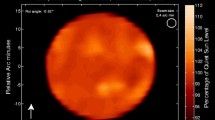Abstract
We explore a significant change of the trend of the transition region network scale variation that occurred around of 2016 when a series of spotless days in 2018, with similar radiative characteristics, were added to previously analyzed days in 2017. We find that a mean per six-year spatial power ratio for 2016 vs. 2010 shows a 29% yearly increase of the dissipation of the network scale, reaching a ratio of 1.74 in 2016. A similar comparison of power ratios for 2018 vs. 2017 gives almost an order of magnitude drop in the previous yearly-mean increase, a yearly ratio of 3%. To study the dynamics of this change, which is consistent with the change of the mean He ii network radius around 2016 mentioned by McIntosh (2019, private communication) based on the method of “watershed segmentation” by McIntosh et al. (Astrophys. J. 730, L3, 2011a), the monthly-mean ratios (MMRs) were analyzed. The MMR profile for 2010 – 2018 calculated for near-a-year time intervals is consistent with the decrease of the dissipation rates during the last couple of years. Such dynamics of the MMRs demonstrates a solar nature of the network scale variation in the transition region and may be used as a new sensitive prediction tool for some existing and future changes of solar activity. The network structure dissipation ratio of about 1.8 for 2018 to 2010 reported in this article may be a signature of such changes, expected, in part, to demonstrate a further decrease of the minimum between Solar Cycles 24 and 25 compared to the two previous minima and a lower solar activity during Solar Cycle (SC) 25. With the current extension of the data to near the next SC minimum, the suggestion expressed by Didkovsky and Gurman (Solar Phys. 289, 153, 2014) that “if spatially resolved measurements of He ii emission are maintained through several solar minima, we should be able to conclude whether the spatial distribution of that emission provides a proxy for predicting cycles with anomalously prolonged minima” has new supporting evidence.




Similar content being viewed by others
References
Alterman, B.L., Kasper, J.C., Stevens, M.L.: 2018, AGU Fall Meeting Abstracts, SH43B-3701.
Bushby, P.J., Tobias, S.M.: 2007, Astrophys. J. 661, 1289. DOI .
Charbonneau, P.: 2010, Living Rev. Solar Phys. 7, 3. DOI .
Delaboudinière, J.-P., Artzner, G.E., Brunaud, J., Gabriel, A.H., Hochedez, J.F., Millier, F., Song, X.Y., Au, B., Dere, K.P., Howard, R.A., et al.: 1996, Solar Phys. 162, 291. DOI .
Didkovsky, L.V.: 2018, Solar Phys. 293, 87. DOI .
Didkovsky, L., Gurman, J.B.: 2014, Solar Phys. 289, 153. DOI .
Didkovsky, L.V., Wieman, S., Korogodina, E.V.: 2017, Solar Phys. 292, 32. DOI .
Didkovsky, L.V., Judge, D.L., Wieman, S., McMullin, D.: 2010, In: Cranmer, S., Hoeksema, T., Kohl, J. (eds.) SOHO-23: Understanding a Peculiar Solar Minimum, Astron. Soc. Pacific C.S. 428, 73.
Hovestadt, D., Hilchenbach, M., Bürgi, A., Klecker, B., Laeverenz, P., Scholer, M., Grünwaldt, H., Axford, W.I., Livi, S., Marsch, E., Wilken, B., Winterhoff, P., Ipavich, F.M., Bedini, P., Coplan, M.A., Galvin, A.B., Gloeckler, G., Bochsler, P., Balsiger, H., Fischer, J., Geiss, J., Kallenbach, R., Wurz, P., Reiche, K.-U., Gliem, F., Judge, D.L., Hsieh, K.H., Möbius, E., Lee, M.A., Managadze, G.G., Verigin, M.I., Neugebauer, M.: 1995, Solar Phys. 162, 441. DOI .
Judge, D.L., McMullin, D.R., Ogawa, H.S., Hovestadt, D., Klecker, B., Hilchenbach, M., Möbius, E., Canfield, L.R., Vest, R.E., Watts, R., Tarrio, C., Kuehne, M., Wurz, P.: 1998, Solar Phys. 177, 161. DOI .
Lemen, J.R., Title, A.M., Akin, D.J., Boerner, P.F., Chou, C., Drake, J.F., Duncan, D.W., Edwards, C.G., Friedlaender, F.M., Heyman, G.F., et al.: 2012, Solar Phys. 275, 17. DOI .
Maunder, E.W.: 1890, Mon. Not. Roy. Astron. Soc. 50, 251.
McIntosh, S.W., Leamon, R.J., Hock, R.A., Rast, M.P., Ulrich, R.K.: 2011a, Astrophys. J. Lett. 730, L3. DOI .
McIntosh, S.W., Kiefer, K.K., Leamon, R.J., Kasper, J.C., Stevens, M.L.: 2011b, Astrophys. J. Lett. 740, L23. DOI .
Pesnell, W.D.: 2008, Solar Phys. 252, 209. DOI .
Pesnell, W.D., Thompson, B.J., Chamberlin, P.C.: 2012, Solar Phys. 275, 3. DOI .
Petrovay, K.: 2010, Living Rev. Solar Phys. 7, 6. DOI .
Williams, P.E., Pesnell, W.D.: 2011, Solar Phys. 270, 125. DOI .
Acknowledgements
This work was supported in part by NASA Prime Award NAS5-02140 within the subcontract 1553591 between the University of Colorado and the University of Southern California. SOHO is a project of international cooperation between NASA and ESA. The author thanks the referee for the constructive comments that helped to improve the content of this article.
Author information
Authors and Affiliations
Corresponding author
Ethics declarations
Disclosure of Potential Conflicts of Interest
The author declares that there are no conflicts of interest.
Additional information
Publisher’s Note
Springer Nature remains neutral with regard to jurisdictional claims in published maps and institutional affiliations.
Rights and permissions
About this article
Cite this article
Didkovsky, L. Quiet-Sun EUV He ii (30.4 nm) Spatial Power Ratios and Network Dissipation Trend for 2010 – 2018. Sol Phys 294, 98 (2019). https://doi.org/10.1007/s11207-019-1483-x
Received:
Accepted:
Published:
DOI: https://doi.org/10.1007/s11207-019-1483-x




